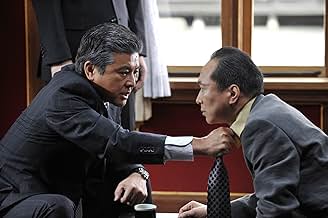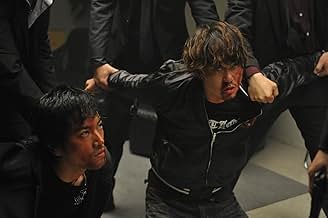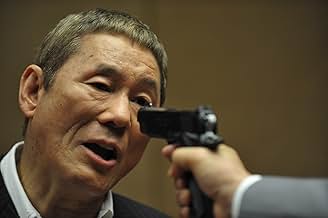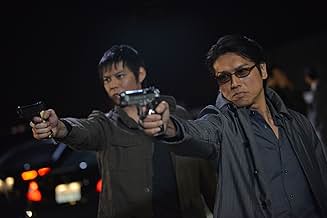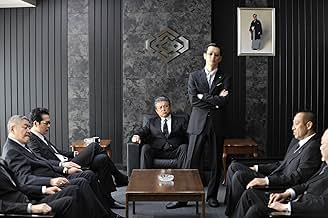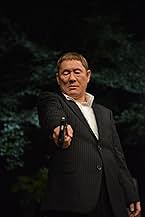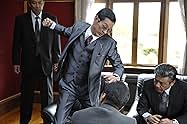ÉVALUATION IMDb
6,7/10
7,6 k
MA NOTE
Ajouter une intrigue dans votre langueAs the police launch a full-scale crackdown on organized crime, it ignites a national yakuza struggle between the Sanno of the East and Hanabishi of the West.As the police launch a full-scale crackdown on organized crime, it ignites a national yakuza struggle between the Sanno of the East and Hanabishi of the West.As the police launch a full-scale crackdown on organized crime, it ignites a national yakuza struggle between the Sanno of the East and Hanabishi of the West.
- Prix
- 3 victoires et 7 nominations au total
Takeshi Kitano
- Otomo
- (as Beat Takeshi)
Avis en vedette
In Takeshi Kitano's Outrage, we sat through some heavy plotting and counter-schemes where every one, a collective of Yakuzas and gangsters, is a bad guy, fighting over power and control when being unwittingly manipulated, together with shifting alliances. The story was pretty brilliant then, since you're really unsure how the concocted plans would turn out, suffice to say it boiled down to very violent affairs, with plenty of firearm action all round.
But Kitano kept his direction well balanced then, as he does so again now, with dramatic scenes happening in the first half of the film, followed by a build up to various violent crescendos in the latter half. We continue where we last left off, where the victors of the first film's schemes, Kato (Tomokazu Miura) and the Otomo Clan turncoat Ishihara (Ryo Kase) return to the top of the food chain, grabbing control over the Sanno-kai crime organization, although not without their detractors from within who will jump at every seductive, suggested opportunity to usurp the throne. It didn't help that their leadership style, parallel to some real world techniques of cost cutting stinginess, doesn't cut it through the rank and file.
And you just can't put a good man down, or a bad man in this case, with Beat Takeshi's Otomo returning to the mayhem as orchestrated by Detective Kataoka (Fumiyo Kohinata). Wait a minute, didn't we witness his key scene in the finale of Outrage? I suppose if one is at the creative helm of the film - directing, writing and editing - then anything's possible. Otomo, as it turns out, is still sitting pretty in prison, but has his enemies quaking in their shoes when rumours got squashed, and Kataoka accelerates Otomo's parole to get him released and back in the fray. With preference for a lowly life amongst the hood, it is genre mantra that one never walks away, but gets pulled back into the hustle and bustle of vengeance and violence.
Between the two films, perhaps I will have to throw my hat of preference over to the first one, if only for a plot that involved a lot more stakeholders, and on screen violence that was more balletic than this follow up's rather tame, and usually off-screen mayhem. Sometimes we get to see flashes from muzzles, compensated by the awesomely rendered loud sounds of multiple rounds leaving the chamber of the gun. And stylistically, which is a fair counter- point to the explicitness of what Hollywood does today, we find ourselves staring down barrels of guns on screen, before cutting to the aftermath.
When put together, while the films touches on tit-for-tat revenge, and perhaps contain a shade of real world organizational politics given the structure of the Yakuza, not only do we get to compare leadership styles and skills of those at the top, but rather how one should be aware of the little man running around, stirring trouble only for personal benefit. Fumiyo Kohinata steals the show each time he comes on screen as the corrupt Detective Kataoka, on the payroll of the force and striving to go up in his career ladder, while on the take from the clans, yet at the same time scheming against all to advance his personal agenda at both sides of the law.
I had nothing but chuckles especially during an interrogation scene which Kataoka engineers, which probably cuts a little close to home given the series of gaffes in high profile court cases that didn't quite put the Home Team in good light. And characters like Kataoka, are not hard to imagine nor stranger than fiction. His opposite would be the ramrod straight Shigeta, who for all his righteousness, couldn't influence the corruption going on in his face, as executed in arrogant style by his counterpart. It's really Kataoka's show from the get go, being the key character, and catalyst in almost all twists and turns, with Fumiyo Kohinata being the quintessential villain amongst all villains here.
But Kitano kept his direction well balanced then, as he does so again now, with dramatic scenes happening in the first half of the film, followed by a build up to various violent crescendos in the latter half. We continue where we last left off, where the victors of the first film's schemes, Kato (Tomokazu Miura) and the Otomo Clan turncoat Ishihara (Ryo Kase) return to the top of the food chain, grabbing control over the Sanno-kai crime organization, although not without their detractors from within who will jump at every seductive, suggested opportunity to usurp the throne. It didn't help that their leadership style, parallel to some real world techniques of cost cutting stinginess, doesn't cut it through the rank and file.
And you just can't put a good man down, or a bad man in this case, with Beat Takeshi's Otomo returning to the mayhem as orchestrated by Detective Kataoka (Fumiyo Kohinata). Wait a minute, didn't we witness his key scene in the finale of Outrage? I suppose if one is at the creative helm of the film - directing, writing and editing - then anything's possible. Otomo, as it turns out, is still sitting pretty in prison, but has his enemies quaking in their shoes when rumours got squashed, and Kataoka accelerates Otomo's parole to get him released and back in the fray. With preference for a lowly life amongst the hood, it is genre mantra that one never walks away, but gets pulled back into the hustle and bustle of vengeance and violence.
Between the two films, perhaps I will have to throw my hat of preference over to the first one, if only for a plot that involved a lot more stakeholders, and on screen violence that was more balletic than this follow up's rather tame, and usually off-screen mayhem. Sometimes we get to see flashes from muzzles, compensated by the awesomely rendered loud sounds of multiple rounds leaving the chamber of the gun. And stylistically, which is a fair counter- point to the explicitness of what Hollywood does today, we find ourselves staring down barrels of guns on screen, before cutting to the aftermath.
When put together, while the films touches on tit-for-tat revenge, and perhaps contain a shade of real world organizational politics given the structure of the Yakuza, not only do we get to compare leadership styles and skills of those at the top, but rather how one should be aware of the little man running around, stirring trouble only for personal benefit. Fumiyo Kohinata steals the show each time he comes on screen as the corrupt Detective Kataoka, on the payroll of the force and striving to go up in his career ladder, while on the take from the clans, yet at the same time scheming against all to advance his personal agenda at both sides of the law.
I had nothing but chuckles especially during an interrogation scene which Kataoka engineers, which probably cuts a little close to home given the series of gaffes in high profile court cases that didn't quite put the Home Team in good light. And characters like Kataoka, are not hard to imagine nor stranger than fiction. His opposite would be the ramrod straight Shigeta, who for all his righteousness, couldn't influence the corruption going on in his face, as executed in arrogant style by his counterpart. It's really Kataoka's show from the get go, being the key character, and catalyst in almost all twists and turns, with Fumiyo Kohinata being the quintessential villain amongst all villains here.
The movie Beyond Outrage can be considered as perfect sequel for the movie Outrage (2010). It is a satisfying as a sequel and more unpredictable and crazier than first part. Gang politics, rivalry and violence became even more intensifies in this movie and sometimes it is even more chaotic and complex in its nature. Story becomes more thrilling and engaging even though it is more realistic and natural in presentation. Takashi Kitano again created a great Gangster movie in a raw and realistic way and a more natural representation of Gangsters, especially Yakuza. Both first and second Part of the movie are more complex and realistic in nature. Characters are more natural and events happening between them are even more violent and crazier than we thought. Takashi brilliantly portrays how unpredictable will be life for a Gangster. They can face death and betrayal at any time and their life is more unpredictable. Being a gangster is not as good as you think and movies like these portrays these unpredictability brilliantly. A gangster movie should be unpredictable as a detective movie because we don't now what is going to happen next.
"Beyond Outrage" is possible more sober and cynical than the first film, exploring further into the bureaucratic side of the struggle between clans. There seems to be no difference in the ways police, yakuza, and politics work in nowadays Japan: honor is for the weak and any chance is good to betray your partner for a promotion. Character development is again minimal, but at least we have a more charismatic cast this time.
"Beyond Outrage" is the sequel to star and auteur Takeshi Kitano's epic of rival yakuza gangs "Outrage." This film is thrillingly lensed in the way that erstwhile widescreen masters such as Kurosawa and Nyquist used the full frame, and done so with a quintessentially oligochromatic Japanese patina. The story has grandeur of conception, keeps you rapt, and slickly amps up the badness of some very bad guys. The violence has larger quantum numbers than the comic book idioms of Tarantino, but is deployed with panache and grace. Among the film's climaxes is vanguard violence that will permanently prefigure how you regard baseball! Here's hoping "Outrage" becomes a trilogy.
I was waiting for a while to see this film and was totally shocked to find out there was a sequel to it's 2010 predecessor. The 2nd instalment is more composed and deals with the politics and characters on a much deeper level. After watching it I am curious as to if this was one screen play cut into 2 films, or, if Tekeshi and co decided to write another script after the original.
Outrage Beyond is a solid piece of crime cinema. The themes of corruption, loyalty, redemption and honour are explored on multiple levels. I loved the cinematography and was really impressed with the solid performances throughout the film. My pick of a great bunch was Tomokazu Miura's portrayal of the aged and weary "Kato".
The ending solidified this Kitano outing as a classic. Great film.
Outrage Beyond is a solid piece of crime cinema. The themes of corruption, loyalty, redemption and honour are explored on multiple levels. I loved the cinematography and was really impressed with the solid performances throughout the film. My pick of a great bunch was Tomokazu Miura's portrayal of the aged and weary "Kato".
The ending solidified this Kitano outing as a classic. Great film.
Le saviez-vous
- Citations
Detective Kataoka: I forgot you were stabbed by that guy Kimura, underboss of that family you crushed.
Otomo: Hey, I never told anybody. Did you arrange that?
Detective Kataoka: I would never.
- ConnexionsFeatured in Zettai ni waratte wa ikenai Nekketsu Kyôshi 24 ji (2012)
Meilleurs choix
Connectez-vous pour évaluer et surveiller les recommandations personnalisées
- How long is Beyond Outrage?Propulsé par Alexa
Détails
- Date de sortie
- Pays d’origine
- Site officiel
- Langues
- Aussi connu sous le nom de
- Beyond Outrage
- Lieux de tournage
- Kobe, Japon(Port where car is dragged out of the water)
- sociétés de production
- Consultez plus de crédits d'entreprise sur IMDbPro
Box-office
- Brut – États-Unis et Canada
- 3 878 $ US
- Fin de semaine d'ouverture – États-Unis et Canada
- 1 938 $ US
- 5 janv. 2014
- Brut – à l'échelle mondiale
- 17 027 515 $ US
- Durée1 heure 50 minutes
- Couleur
- Mixage
- Rapport de forme
- 2.35 : 1
Contribuer à cette page
Suggérer une modification ou ajouter du contenu manquant





